What’s outside the Red Room? At the top of Twin Peaks Season 3, the curtain is lifted, and we find out:
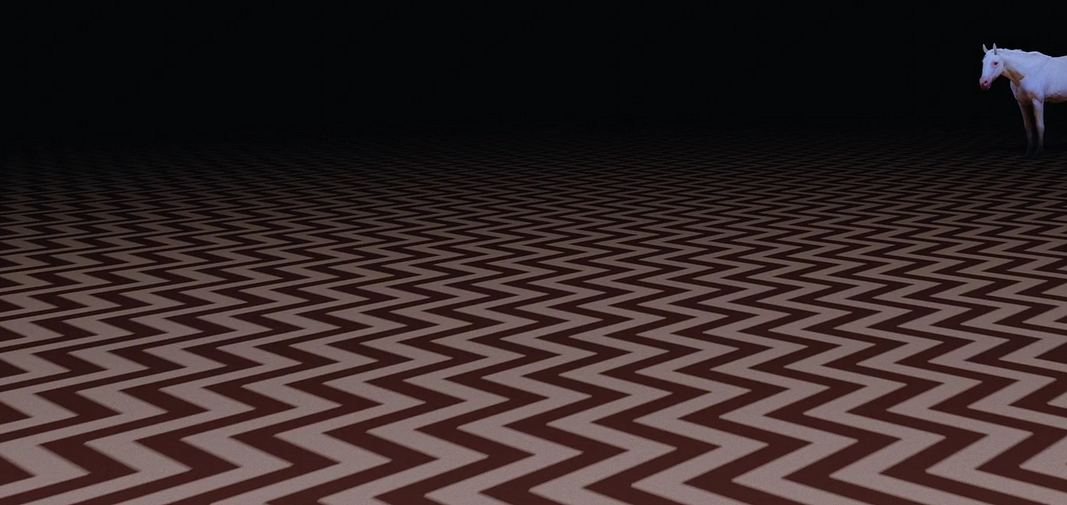
Behold! A white horse, utter darkness, and the rust and white chevron floor that appears to go on forever like a ‘field’, or like an ocean without a shore.
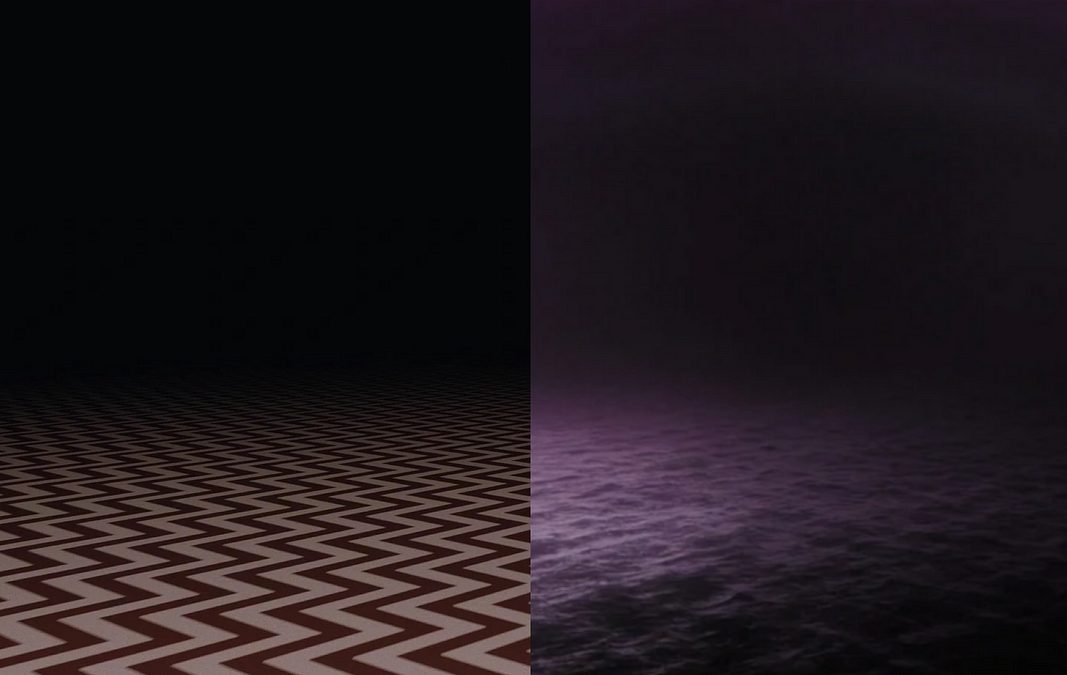
“The Self is an ocean without a shore. Gazing upon it has no beginning or end, in this world and the next.” ~ Andalusian mystic Ibn Arabi (1165-1240)
Like the flowered wallpaper, the chevron pattern is now shorthand for the entire show. Lynch/Frost managed to hack a geometric pattern!
This is the Water
It could be an abstract version of the purple ocean. In Part 1, the cool neon and warm red light of the curtains mix with the rust and white floor to create a hazy purple hue. You can see it better if you blur your eyes.
There is also textual evidence that the pattern points to water: literal water appears beneath it! At the end of Part 1, the floor opens up and Cooper falls into black water reminiscent of Anish Kapoor’s Descension and a dunk tank.
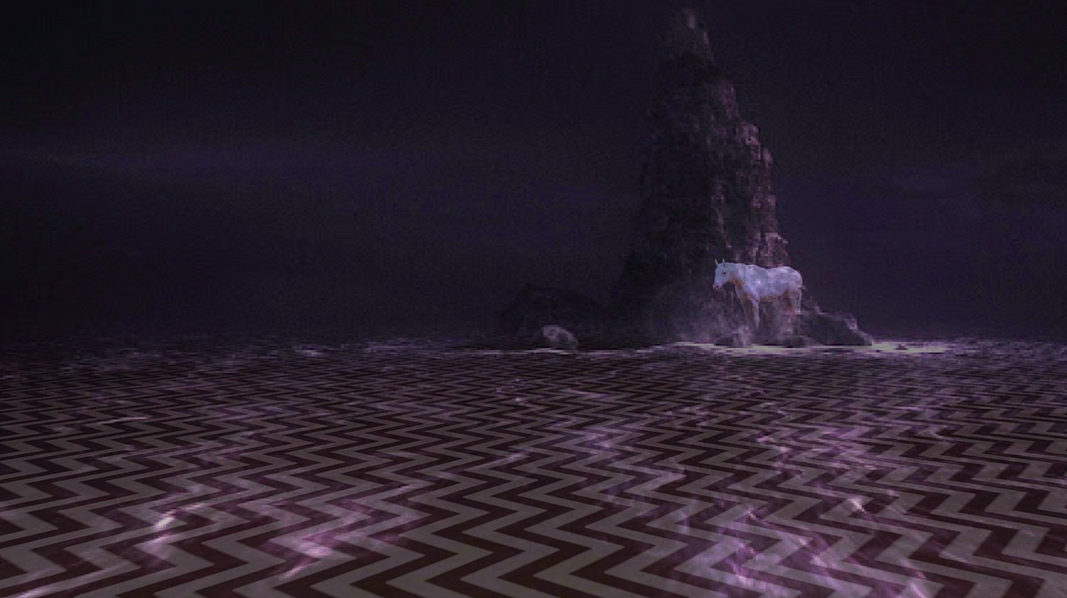
The chevron floor could come from water, but it could also come from the glass boxes and chevron baskets hiding around the Great Northern throughout the pilot. Let’s review current scholarship and popular theories about the pattern, and then look at a new theory (as far as I can tell), and its dark ramifications.
Serrated
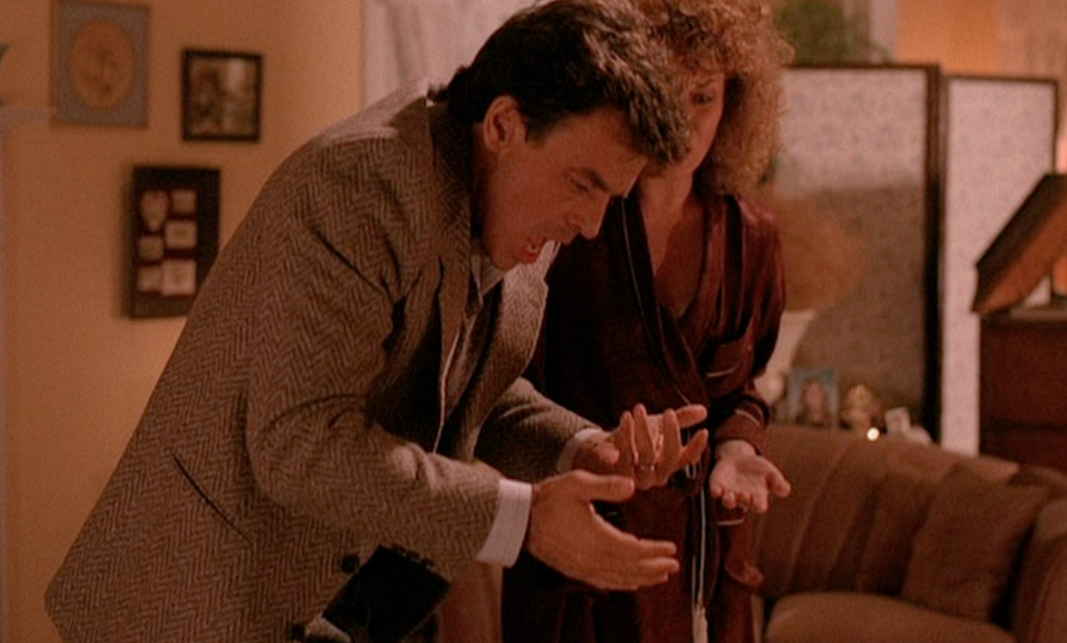
What exactly the serrated lines signify depends on your overall theory about the Red Room.
Within the narrative, Cooper is influenced by Tibetan Buddhism and interprets the entire Red Room experience as coded language from his subconscious pointing to the killer. “Break the code, solve the crime.” It’s precognitive (or is it retrocausal?) in that future and past symbols bounce around, out of order: The dancing man points to Leland’s love of dancing; the grey-haired man is Leland’s sudden gray hair; the “music in the air” is Leland singing and playing records; the “gum you like” is the gum Leland likes, revealed way later; the red curtains are from Jacques’s cabin before the murder happened (or the womb-like rooms at One-Eyed Jacks); and, although he doesn’t say it out loud, fans point out that the chevron floor comes from the pattern on Leland’s Jacket that appears later in that same episode, “Zen.” It was all right there the entire time!
[Tangent: “Zen” is one of the most peculiar hours of television ever to air on a network, not only because of the mesmerizing Red Room, but also because Audrey does her dance; Ben and Jerry do a little ‘dance;’ Josie finds a hidden chamber in some furniture; and it’s when we are dropped in a mise-en-abyme soap opera, “Invitation to Love,” living inside the minds of the main characters. “Zen” reverberates and echoes like FWWM across all of The Return, all the way to the end credits: Lynch apparently used YouTube videos of the episode to help restage the Red Room scenes.]
It’s a stretch, but continuing with this theme—that the Red Room things are clues from the detective’s enlightened subconscious—the chevron pattern could reference the train car, the heart necklace, or the z-twist rope found on the floor of the cabin. Other symbols from the Red Room, like the statue, lamp, and ring, are expressionist clues for the viewers to decipher by themselves; breadcrumbs sprinkled through the show. Case closed.
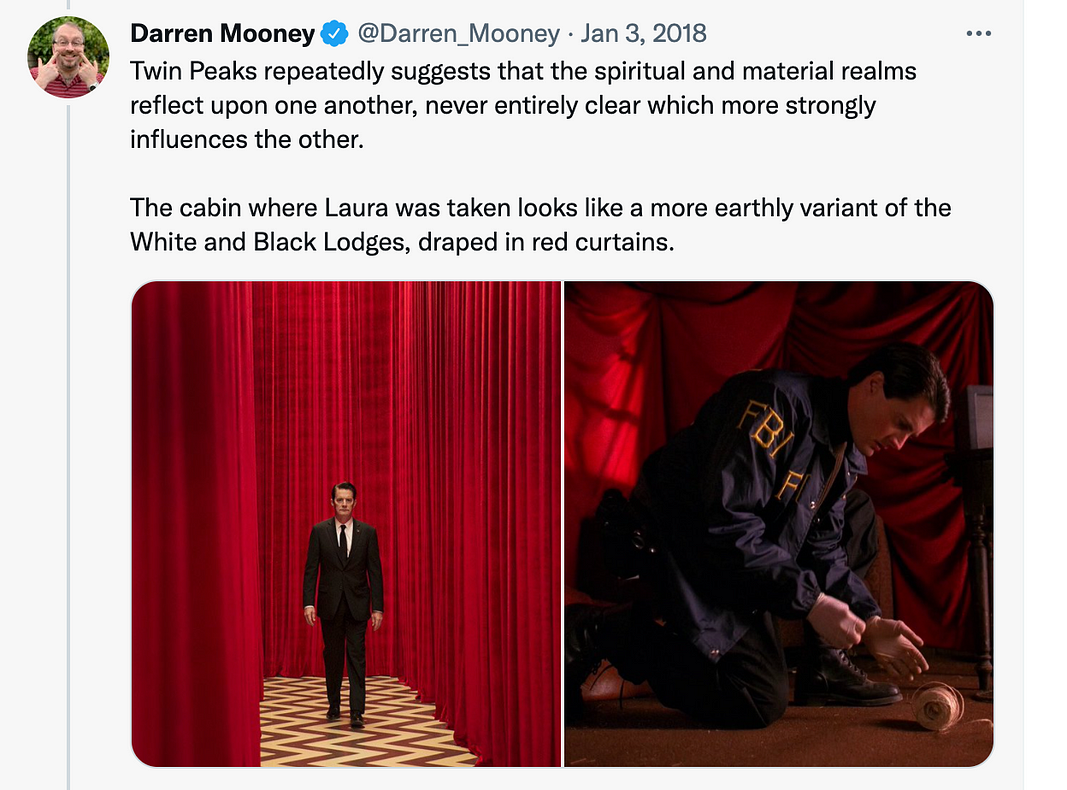
Not quite. The zigzag could be a distraction for Cooper (and us), subtle hypnotism, a psychological weapon meant to loosen his grip on himself (not dissimilar to the enchanting double-eyed Heltsuk formline water monster living behind Ben Horne’s desk). Maybe someone nefarious constructed this room backstage as a trap. Or maybe it’s just Cooper. Here is an analysis of “Cooper’s dream” from Season 3 by writer Rosemary Ross, and it applies to the floor pattern in Season 1, 2, and FWWM: “The distinctive zig-zag pattern on the floor that frequently blurs and shakes represents Cooper’s foundation (his beliefs) that are not on solid ground.”
Unfixed, Cooper appears to be shifting right before our eyes. Maybe the pattern has nothing to do with Leland, or his jacket, or the fact that Ray Wise shed real blood onto Laura’s picture during that scene in Episode 2. (What a coincidence!) Maybe it’s all from Cooper.
Or not. We know that before she died, in a precognitive time-loop or retrocausation—“pre-shocks of future trauma”—Laura dreamt of Cooper and the chevron pattern.
Wayfinding
If the chevron pattern is from Lynch’s dream, then art historians might recognize the floor as op art—a nod to painters Victor Vasarely, Julian Stanczak, Franco Grignani, and Bridget Riley. It’s very modern, and may also reference Lynch’s love of his Frank Loyed Wright house which features chevrons on the walls and around the swimming pool. Jennifer Lynch apparently has some chevrons from the poolhouse displayed like sculptures on top of her fireplace. A striking chevron floor also appears in the 1950’s film Orphée (Orpheus) by Jean Cocteau, one of Lynch’s favorites. “In my opinion, Cocteau is the heavyweight of surrealism.” Perhaps the floor is merely a reference to Cocteau’s Orpheus, a story that infuses and leavens all of Twin Peaks.
If it’s Cooper’s dream, then who knows: the zigzag could symbolize mountains, the Tibetan Himālāyas—he’s walking across them like a gigantic Buddha-cop! The Red Room could be symbolic for the Buddhist “storage-house consciousness” in Cooper, an “Eighth Consciousnesses,” ālāya-vijñāna, where “seeds” leave karmic “impressions” that dictate the future.
“Do you have the seed?”
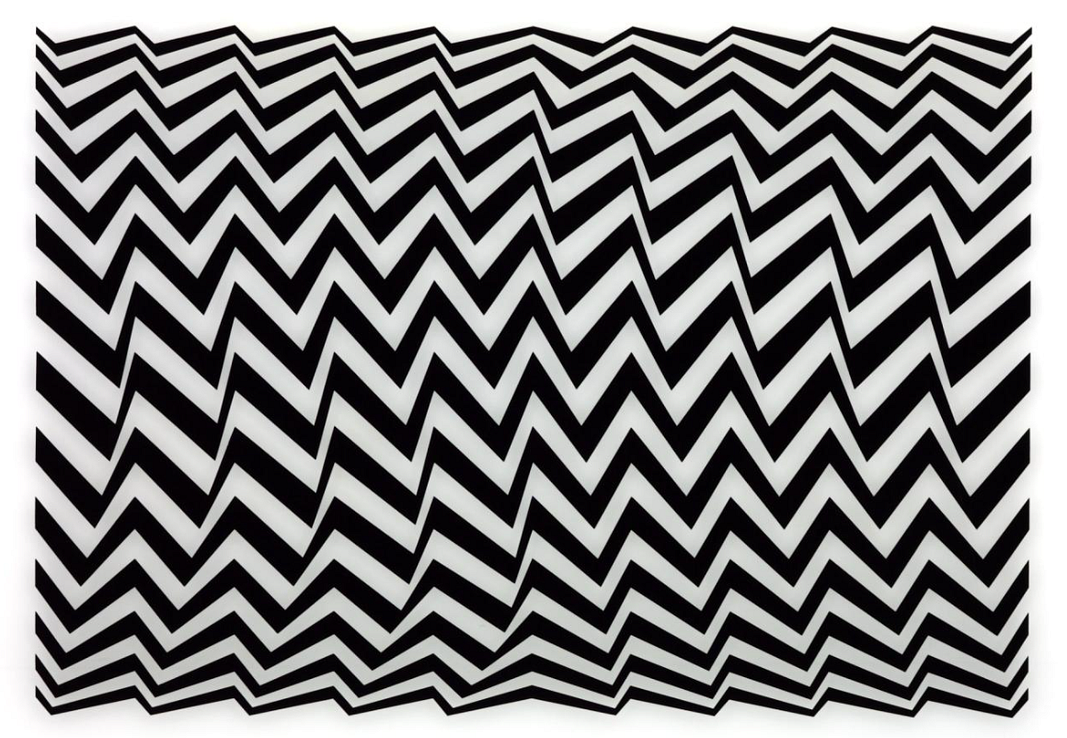
Zora Burden, in Another Place: The esoteric symbolism of Twin Peaks, links the chevron pattern to Theosophy (Golden Dawn) and the “zigzag path” through the Sephiroth aka Tree of Life: a ten-colored pattern (read chakras) also called The Flaming Sword. There is even a shakti-like snake that weaves its way up through this ancient Jewish kosmogram. It’s fantastic! And no doubt Lynch/Frost/Coop would be aware of Hermetic, Kabbalist mysticism. All these symbols swim in our subconscious.
Further, Burden points out that the Kabbalistic lightning sword relates to a Tibetan Buddhist vajra or diamond scepter/mind protector—Indra’s weapon-turned-yantra; Kukai’s sex magic dance partner. More, the zigzag pattern resonates with the two channels of shakti rising up the spine, and the two snakes rising up the Staff of Hermes. Lots of semen imagery, lots of dick.
This symptomatic reading sees the symbols in the Red Room as pointing beyond the text and into other mental spaces that influence Cooper et al. Unfortunately, this kind of hermeneutics can quickly get, as Susan Sontag puts it, lost in translations, eclipsed by shadow worlds. Maybe we should stick to the text.
Back to the subject: Formally, the eye-dazzling pattern generates phantom contours, and it kind of pulls you forward, beckons you, gets you moving peak-to-peak, not unlike the tile patterns in airports designed to get you shopping. They’re like little arrows. Listen to 99% Invisible‘s episode called “Walk this way” for a great meditation on floor design and agency. Sometimes it’s literally a meandering yellow brick road and before you know it you’re eating a Cinnabon you didn’t even want. I love how the old Kansas City MCI airport floor is a blue starfield covered in planets, yantras, and visionary medallions that make you feel like you’re Cooper jumping from world to world.
“On the loose, on the loose, feeling so wild and free.” This floor gets you moving, and remember Laura was always moving. We move to avoid things. Many people who experience trauma feel like they need to hurry; they have “hurry sickness,” are always jangling their keys, chasing their own tail, in a hurry to get a massage, in a hurry to go on vacation. And what’s maddening is that when we are in a hurry, we are more likely going to make a mistake that will slow us down, even ruin everything. This is why some of us have to practice slowing down.
Zzzzzzzz
New-Age dreamers connect the ubiquitous zigzag to the letter Z, a symbol that also appears throughout Twin Peaks. This site claims that if you dream of a Z or zigzag, beware! “The dream suggests that there is a lot of energy that is going through you. Therefore, at one point, you will need to discharge it to maintain balance.” Palmer House at the end of The Return? I can’t believe the Z is a tautological sign that you’re literally catching some Zs. So silly!
The Z, as in “from A to Z,” also means “end.”

David Harrison notes that the floor resembles a “zig-zag version of the Mosaic Pavement in a Masonic lodge,” and this would definitely be in the subconscious of an F.B.I. agent like Dale Cooper. Harrison’s lodge-ic is that this connects to the names Black Lodge and White Lodge. He also presents a great theory for the backward speaking of the Red Room that ties Lynch and Twin Peaks to the profound weirdness of Sgt. Pepper’s.
I don’t think we need to look outside the show—to Theosophy, Buddhism, or Freemasonry—to find the origin of the pattern, but while we’re at it, chevrons have specific histories in what is currently called the USA. In some tribal paintings of animals, a serrated line is drawn passing through the body like a spirit. Zigzag designs were also painted literally onto Plains Indian warhorses who were also taught to “dance” because “if they stayed still for more than a second, they became a target.” Hopi Kachina dancers (especially Buffalo dancers) hold zigzag lightning bolts in their hands and shake them like rattles. (Listen to the sounds). Apache Crown Dancers appear to embody the Red Room itself.
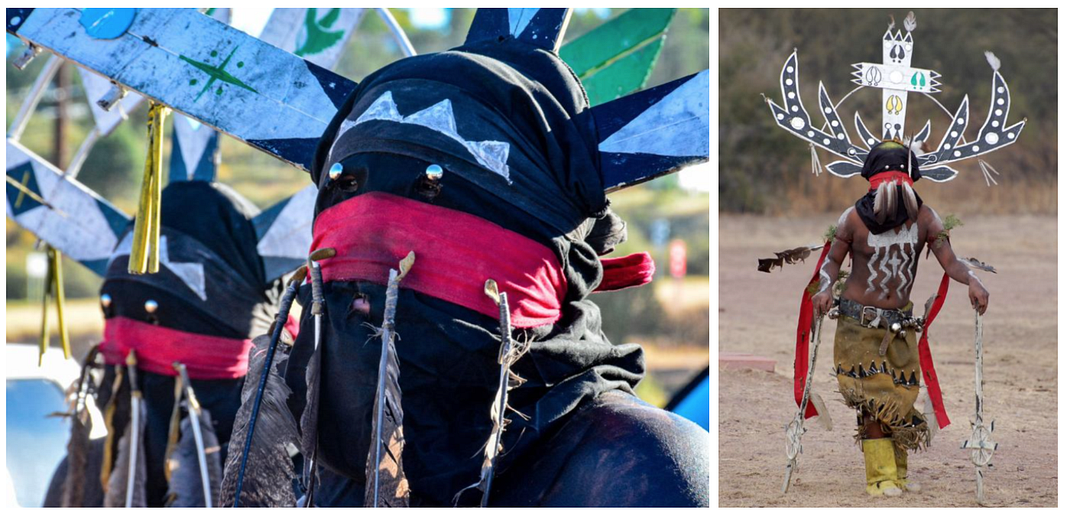
Many Pueblo and Navajo artists link the zigzag to a range of beings, from lightning, thunder, and storms, to rattlesnakes, water, and even to the Horned Toad Lizard. There is a great story called “Horned Toad Meets Lightning,” where Lightning challenges Toad to see who is stronger and faster. Toad agrees, and the gigantic bolt tries to strike him down four times but misses because Toad slightly tilts his body at just the right moment each time.
In return, Toad uses the spikes on his head to hit back at Lightning, which “sent a fierce bolt of electricity that splintered into a vast array of smaller strikes, which quickly exploded wildly across the sky.” The story is a fable for why lightning is cracked and fractured, (and TP scholar Lou Ming might say that this frog-hybrid is why the “one became the many”).
There is another Navajo story where the chevroned creature is used as a mask by one of the hero twins to frighten away a giant.
This tiny desert creature is known to squirt blood out its eyes. Navajo people sometimes call it Grandfather, while spider is Grandmother.
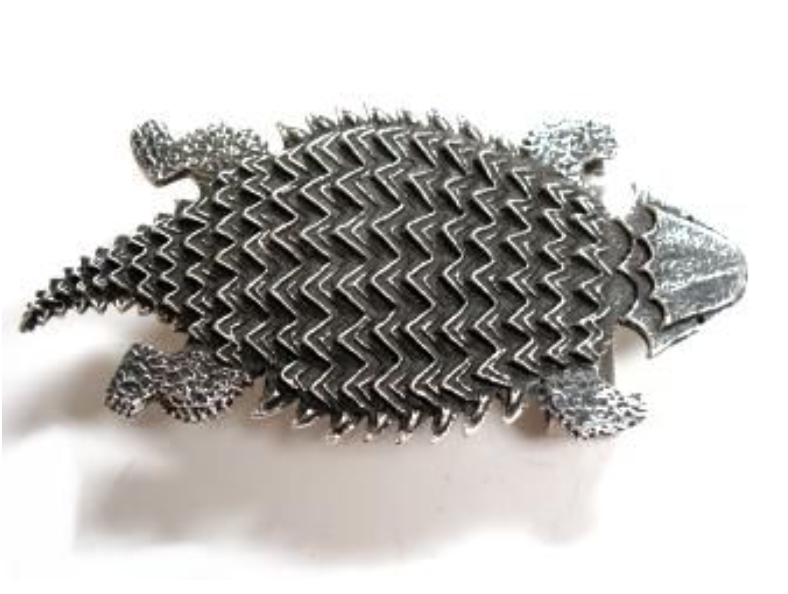
The zigzag also appears on the “stepped fret.” Leaves along the stem of the corn plant correspond to the zigzag pattern along the stem of the cosmic corn plant at the center of the Navajo universe. In the Pollan Path sand painting motif reproduced in Joseph Campbell’s The Inner Reaches of Outer Space (1986), human people follow the corn-infused zig-zagging footsteps that move the experiencer from one world to another. In Navajo cosmology, there are at least four worlds: black, blue, yellow, and white/ glittering, related to the mathematical dimensions, and, oddly enough, loosely correspond to the Tibetan bardos we pass through at death.
Franck Boulègue, in The Return of Twin Peaks: Squaring the Circle (2021) calls the chevron floor “a visual ode to vibrations” and extrapolates vibration and oscillation as key themes throughout the show. The pattern appears on dresses, jackets, a sofa throw at the Palmer’s, and in Season 3 the entire Red Room appears everywhere Cooper is as if somehow projected from his own consciousness.
Many believe the chevron pattern is a representation of a broken TV signal aka white noise. It could also be radio waves, even brain wave patterns. Redditor BumbleWeee sees them as lightwave patterns that indicate a relationship to the spectrum of consciousness and so-called “root chakra,” which is also why the Saturn lamp is there. Saturn is associated with that chakra, but it’s also in the Tree of Life: the sephira of Binah, wisdom; black.
BumbleWeee also compares the rectilinear chevron floor to the curvilinear pattern in the floor at the Fireman’s Fortress, a place that perhaps represents a “higher,” or in this case, deeper, more fluid level of consciousness. They also beautifully juxtapose the Red Room from Season 2 with the Pink Room from FWWM.
[Quantum and chaos magic suggest that, by looking back into the past, you can plant seeds in the present (someone else’s past) to grow a better future. Plant them now. We are four-dimensional maybe even five-dimensional creatures, and through dreams we sometimes get caught in what Eric Wargo calls “time loops”—self-fulfilling prophecies where effects become their own causes.]
Go now!
Franck Boulègue in Unwrapping the Plastic likens the chevron pattern to brainwave patterns captured on an EEG machine, specifically the delta waves produced during deep sleep. He admits that the pattern could also symbolize water, and that we may as well be looking at a statue of Lakshmi, “the Hindu equivalent of Venus…”
Water is a symbol for the so-called feminine—nymphs, succubi, sirens, Charybdis, and mermaids who’ll pull you under (see Elaine Morgan’s Aquatic Ape hypothesis and Jess Zimmerman’s Women And Other Monsters). Water is synonymous with the subconscious (it’s impressionable), with foul smells, and with danger; that the surface can return to normal after swallowing someone up makes is associated with deception. Oceans also point to transcendental levels of consciousness. Gaddis:
Maybe we’re fished for, by supercelestial beings.
Pioneering water researcher, Theodor Schwenk, considers water to be the mediator between earth and sky, as well as a potent archetypal model for the flow of time itself. “There is such unlimited movement in this sheath of water encompassing the earth that on a global scale it can be regarded as an organ mediating between earth and cosmos, integrating the earth into the course of cosmic events and enabling it to take part in these events.”

Lacanian psychoanalysts might see the zigzag pattern as a visualization for the “repetition automatism,” the repeated acting out of an unconscious desire—back and forth, back and forth—the “compulsive repetition or reproduction of an internalized social structure which the subject repeatedly and compulsively re-enacts.” Lacan also marks it “the insistence of the letter” or signifying chain (see Eric Savoy’s Jacques Lacan, Walk with Me: On the Letter. See also Why Theory‘s recent episode and Lacanian analysis of The Return). For Lou Ming, author of Find Laura, this signifying chain could be the insistence on the reality of BOB and Cooper.
From a psychoanalytic perspective, then, we could say that the endless zigzag pattern relates to aimlessly searching for something, scouring every nook and cranny, and having it be right under your nose—like a key on someone’s wrist—the entire time. This probably parallels the idea of repeating certain patterns/behaviors with the unconscious intention of avoiding death; another emblem for the themes of the show and the days of our lives.

Diane
Others think, and it’s more than just suggested in the show itself, that the chevron floor comes from Diane’s nail polish (or is it the other way around?). In Part 17, she materializes out of Naido sporting a red wig (the curtains) and black and white nail polish (the chevron floor). Her pink floral robes even evoke the floral wallpaper from the Doorway Picture. Suddenly we are interpreting our dream the way Cooper interpreted his.
We saw Diane in another “waiting room” in Part 9, and then in another Red Room at the opening of Part 12, when the red curtains appear at a secret FBI meeting. They draw our attention to the floor pattern that looks similar to the carpet from The Shining, (looping back around to Eraserhead and the chevrons). And then, as if reading our minds, a pantomime smoking Diane says “Let’s Rock.” This is a key phrase uttered as if by the Red Room and chevron pattern itself.
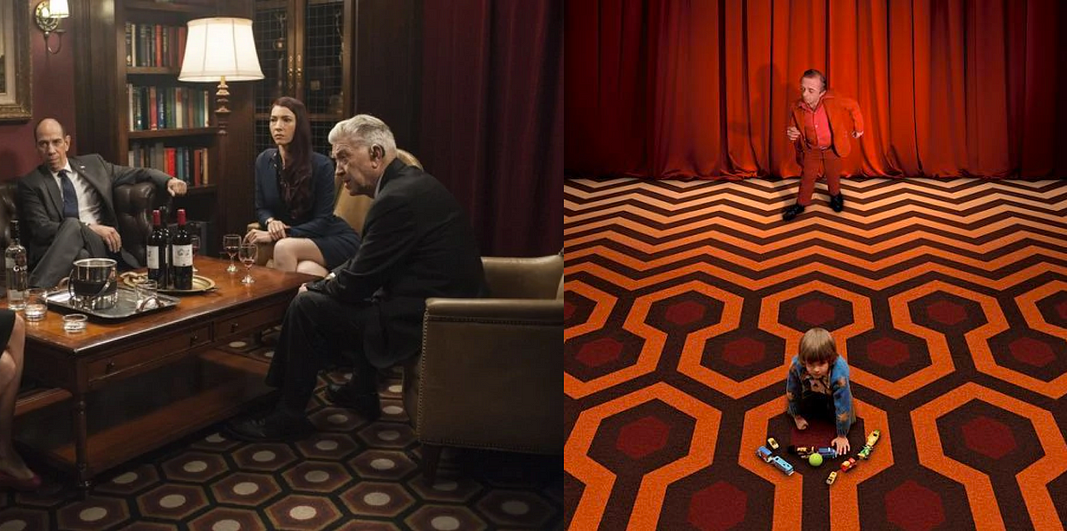
This reminds me of the Diane podcast episode “Where is Dale Cooper?” when Rosie sees the Red Room scenes as a rough restaging of that famous sequence from FWWM—of Cooper in the Philidelphia Office moving in and out of rooms, looking for something, seeing himself split, being confused. There is some strange magic afoot, doors open and close, and unexpected people appear and then disappear.
Tim Kreider, in But Who Is The Dreamer, also brilliantly points out how Judy’s in Part 18 imitates the Red Room: “there are no tables in the center of the restaurant, just a bare expanse of burnished floor.” Moreover, a white mechanical horse is just outside. “But are these supposed to be signs from the spirit world that Cooper is on the right track, and that Carrie really is Laura—or has Richard just incorporated these knickknacks from real life as mythic symbols in his elaborate dream world?”
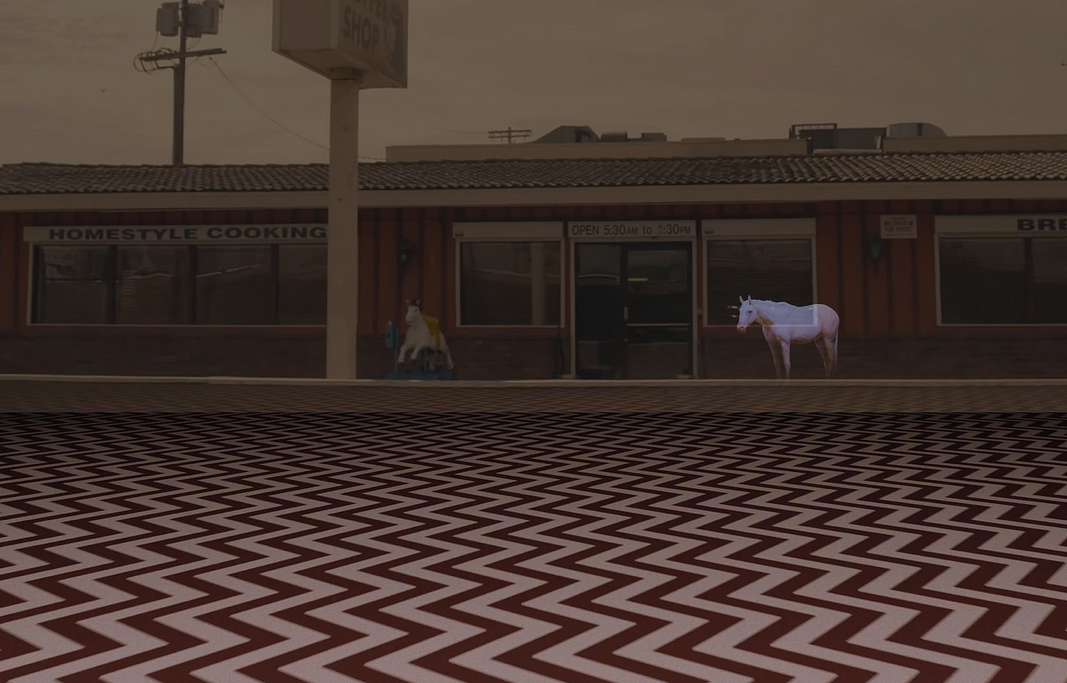
Laura
The universe is even bigger on the inside. The human mind, our inner life, is so vast! Writers know the content from one minute of life can fill an entire novel (or an 18-hour film). Tim Kreider, Lou Ming, and others ask that we consider that much of Twin Peaks takes place inside someone’s head, and the kicker is, the main character might not be who we think it is.
I like Lou Ming’s Find Laura hypothesis. From Ming’s perspective, all the characters in Twin Peaks are of Laura’s own making—but not from just one fleeting dream (although normal, everyday dreams do seem like epic movies when we remember them—don’t they?). No, these characters are part of an ongoing inner world, very old but always current. And who knows; Laura Palmer herself may even be a dream-girl, an avatar or alter-ego of some other “woman in trouble.” Maybe she’s part of Teresa Bank’s death dream, or, better yet, Diane Selwyn’s.
Charlie Kaufman’s tip for the actors in I’m Thinking of Ending Things: “It’s like the characters are all part of the same mind.” Our mind? Lynch’s mind? Laura’s mind? Ming’s theory doesn’t mean that the people are mere figments, that they don’t exist in “real life,” and it doesn’t mean that these dream versions can’t get lost in their own dream roles and be ‘actors’ with ‘agency.’ Like the name-shifting woman in I’m Thinking of Ending Things, some characters even think that they’re the protagonist.
Partially because her homecoming picture is the “frame” established at the beginning of every part of The Return, Ming thinks it’s all Laura, full stop. “Find Laura.” But I wonder if it could actually be whoever is looking at Laura’s homecoming picture? We enter it like a head entering a pillow.
Who do we know who looks at Laura’s picture, who has it seared into their deepest subconscious? Sarah? Leland? Ben? Us? God, what if Leland is dreaming, stuck repeating, like Annie, the phrase: (to Sarah) “Find Laura”? Yuck.
I think Lou Ming in Find Laura came up with a complementary theory to Tim Kreider’s (which John Thorne marks “the most compelling, sobering essay I’ve read.”) Ming’s theory is as disturbing and beautiful: The Waiting Room and Chevron Floor is an abstracted level of Laura’s subconscious, not Dale’s. “Level” isn’t quite the best metaphor. As psychoanalysts will tell you, the subconscious is not really a “place” so much as it’s a person. In this sense, Krieder’s fractured Cooper is really a personification of Laura’s fractured subconscious and its drives.
Assuming it is Laura, maybe the Red Room with its chevron pattern is an amalgam of many people, places, and things from Laura’s life, and we should look to her diary for clues. Let’s do that, and also compare the floor to other surfaces in Twin Peaks, and get to this new theory.
Baskets and Glass Boxes at the Great Northern

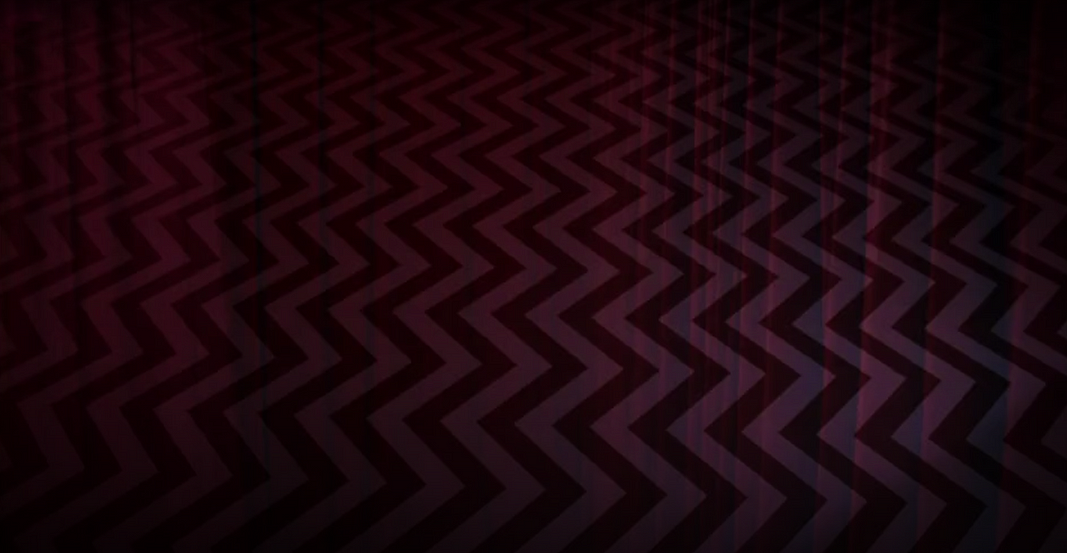

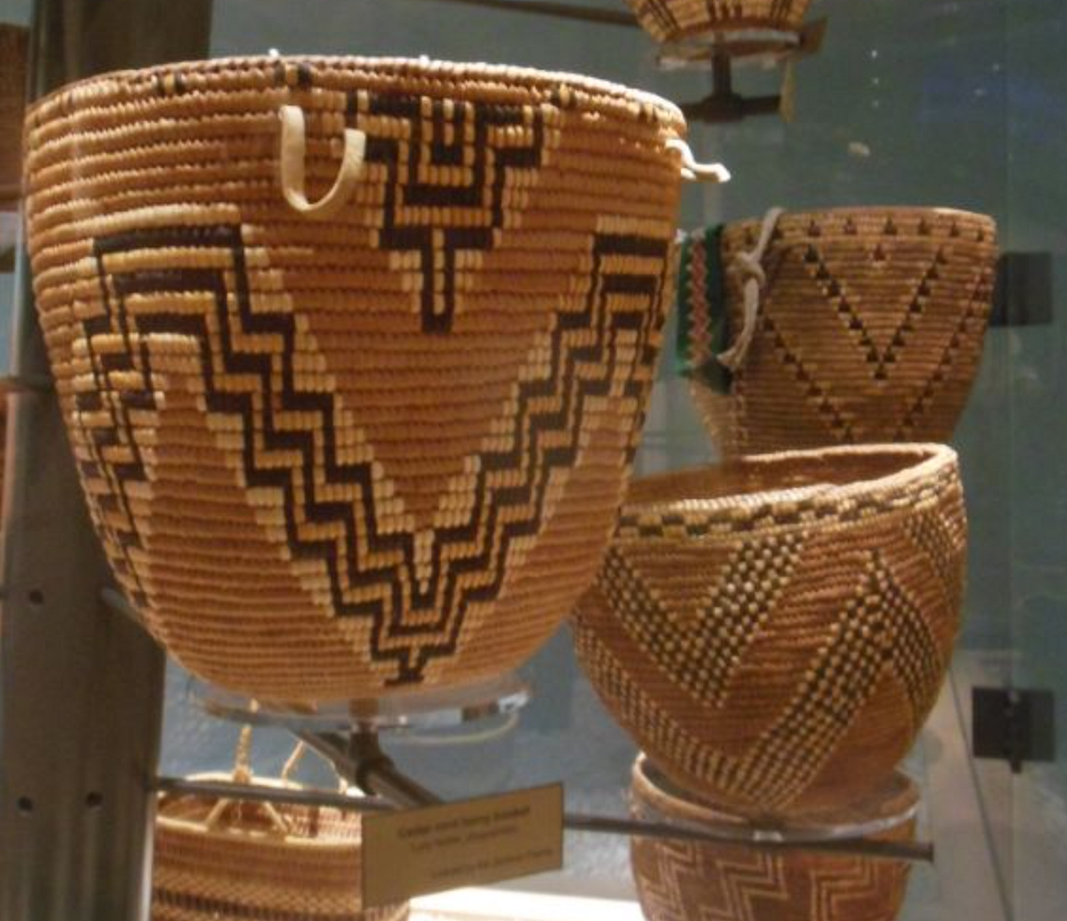
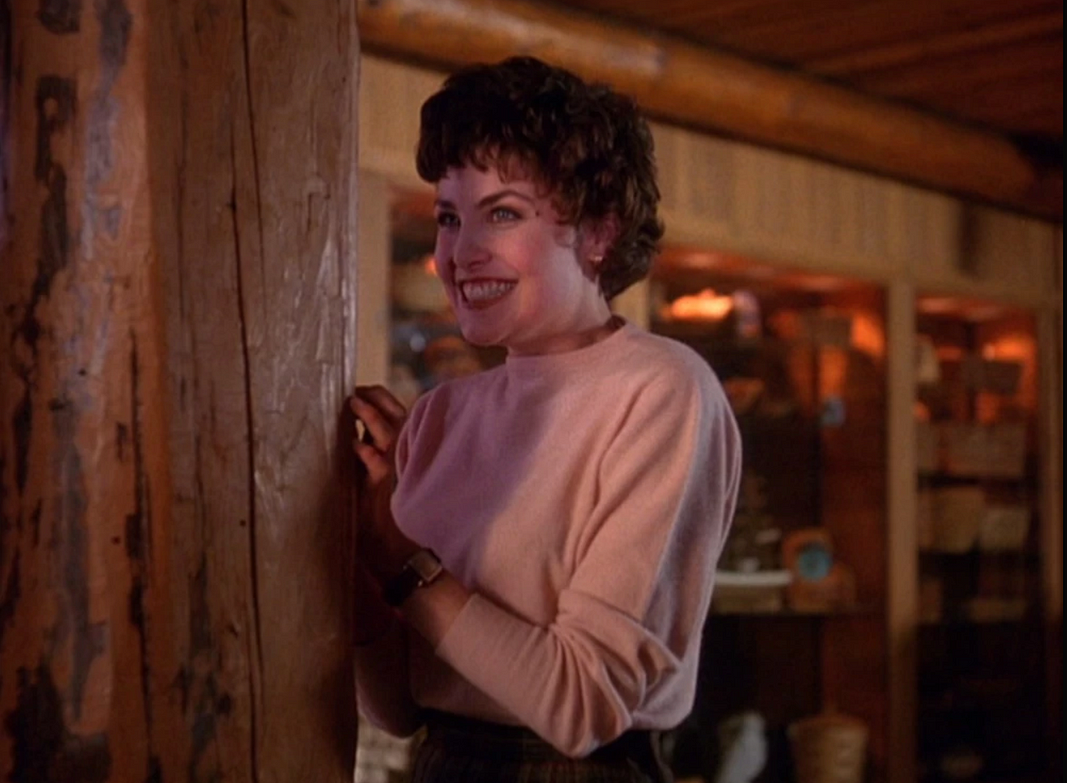
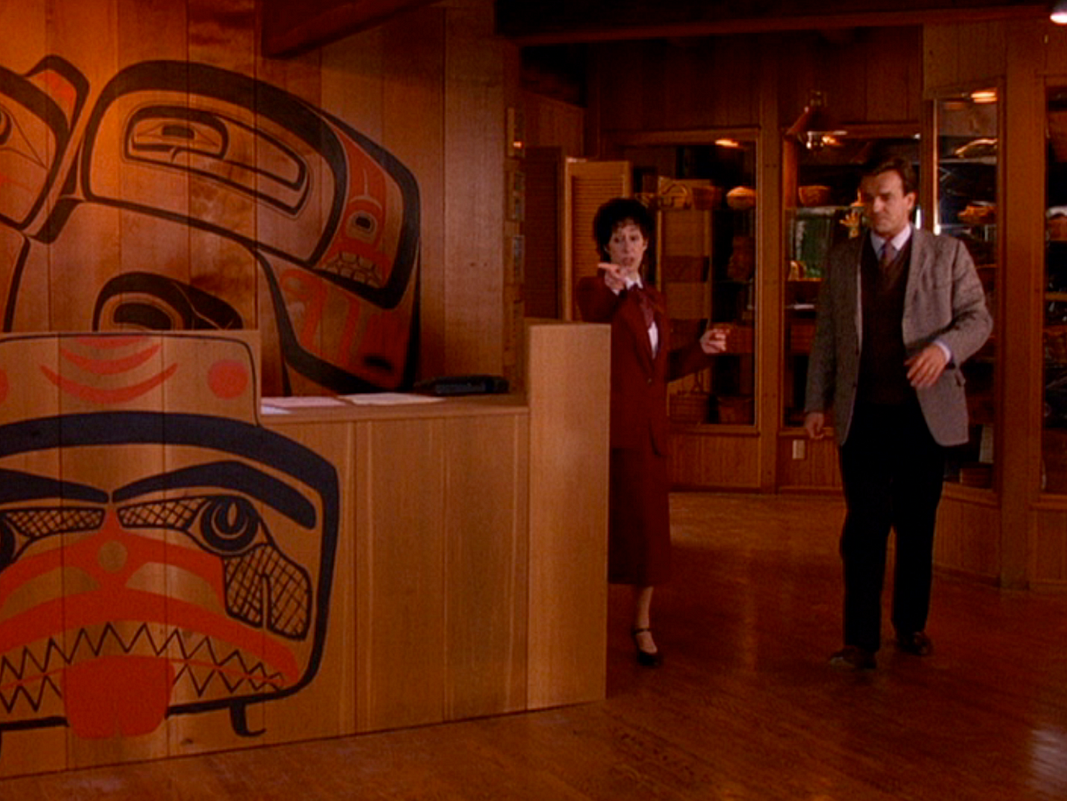
Glass boxes and Suquamish zig-zag baskets greet Laura every time she visits the Hornes. Cooper disappears into the basket zigzag of the Black Lodge, and 25 years later re-appears inside a giant glass box.
My argument hinges on the fact that The Great Northern is also a Native American basket museum. Glass cases filled with baskets line the walls near the entrance and conference rooms. Yes, a chevron floor appears in Lynch’s first feature film Eraserhead, but a quick google search reveals that the chevron pattern also typifies Squamish and Coast Salish baskets.
You can take a digital tour of the Kiana Lodge, where the pilot was filmed, and examine some of the baskets that were likely there in the ’90s. See the chevron? All the Native art we see in the pilot—the masks, totem poles, baskets, paintings—were collected by Robert “Bob” Riebe (1937–2009), the previous owner of the Kiana Lodge. His collection now belongs with the Suquamish Tribe, who purchased the lodge from him in 2004.
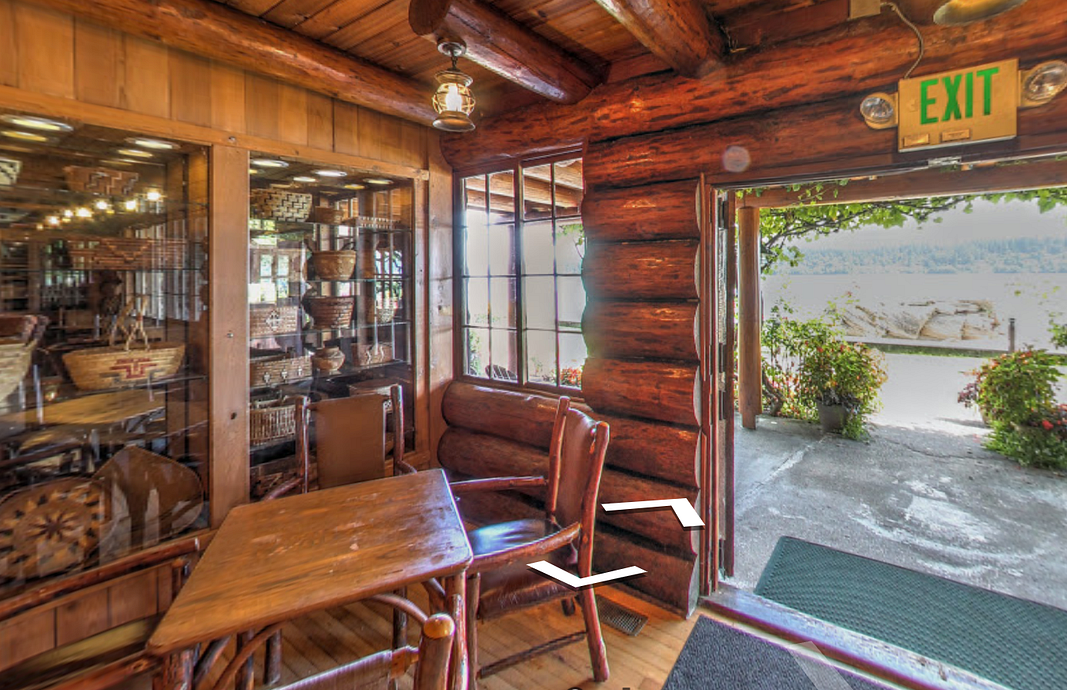


The one in the upper left! Some of the vitrines are also windows into other rooms.

Handmade baskets signal “Native Otherness,” and these ancient artworks with bold zigzag patterns floating alongside totem poles and formline faces no doubt seduced Lynch/Frost. It’s the reason why the Kiana Lodge was chosen as the site for the pilot. Lynch loves chevrons, and those baskets must have captured him the moment he walked in.
They also captured Laura/Cooper. We don’t see it happen, it wasn’t filmed, but within the subtext of the story, Laura will see these patterns time and time again. In her diary, we hear of her visiting Johnny and attending parties at the Great Northern her entire life. I argue, for fun, that if the Waiting Room is conjured from Laura’s mind, then the pattern on the floor is likely a compressed dream-transfiguration of the Great Northern itself and the man behind it—it’s Ben.
Ben and the Diary
Why would Ben Horne be the foundation of the Waiting Room? That answer shines light onto why Laura’s secret temenos has a chevron floor in a way that leads back to the story, back to Ben and to his Laura. In the words of Phil Ford from Weird Studies, “We don’t want to let Laura down.”
Wherever that pattern comes from or wherever it leads should be foundational to her story, and Ben Horne fits that bill. Yet Ben is a person we quickly overlook when delving into Laura. We focus instead on BOB, Leland, Sarah, Cooper. Ben isn’t even in FWWM, which is suspect. He is central to her story.
We also know Ben is a dreamer (he dreamt up an entire civil war), and I’m not suggesting that he could be the dreamer, just that Ben, growing up with Laura, is a foundation for her subconscious.
Before there was BOB, there was Ben—BOB’s Boss.
His role in the development of Laura’s psyche first appears on p. 13 of her diary.
It’s July 30th, 1984. Laura is 13 years old. Maddie brings a bunch of clothes over to try on in front of a mirror. We see Laura turn into other people and love it. “She could tell I was feeling depressed about something, I guess.” […]
Maddie said I looked like Audrey Horne.
We can unpack that statement for weeks, but the next passage says it all (and listen to Sheryl Lee read it in Laura’s voice from Audible if you can):
She’s the daughter of the man, Benjamin Horne, that my father works for. Benjamin is very very very rich. Audrey is a pretty girl but she’s quiet and sometimes mean. Her father doesn’t pay much attention to her, and that’s probably why she acts that way. He has been very attentive to me, however, all of my life. Each time there is a party or a get-together at the Great Northern, Benjamin puts me on his lap or knee and sings to me softly in my ear. Sometimes I feel very bad for Audrey because when she sees him singing to me, it must make her sad because she often runs from the room and doesn’t come back until her mother makes her. Other times I kind of feel good when she runs off. Like I am the center of attention, and that I am more special to him than his own daughter. I know that isn’t nice to say, but I’m just being honest.
We find out that Ben gives Laura a pony shortly after Leland starts raping her. Knowing what we know about Ben—that as soon as Laura becomes a teenager he brings her into his prostitution business and also starts having sex with her himself—this early interest in her body on his lap, in whispering things into her ear, looks very very very bad.
“All Of My Life”
Is the Diary canon? Apparently it was channeled directly from Laura Palmer herself (or a tulpa/egregore) through Jennifer Lynch à la “automatic writing.” So, yes.
It may be worth noting that Laura feels anxiety around the Great Northern. The hotel symbolizes sexual shame and surveillance. We read that when she gets her period, her first thought is fear that Mother told Father, “who has by now told everyone at the Great Northern.” We see blood splattered onto the chevron floor.
Ming’s theory is that the Waiting Room is built by Laura’s subconscious to keep up the ruse of BOB and Cooper, and if this is true, then having the floor be a constant reminder of Ben (and therefore Troy the horse, heartbreak, betrayal, shame, Audrey, self-hatred) makes sense. The chevron is the foundation for a room meant to keep her second-guessing herself.
But then again, maybe the room isn’t an anxiety-inducing panoptic prison, but is instead her “safe space,” and it has a chevron floor because the baskets at the Great Northern signaled safety and release. They remind her of Johnny and his Indian chief’s headdress.
Also, Cooper lives there, in the Red Room, as he lived at the Great Northern for the first two seasons.
Moreover, Horne’s department store leads Laura to an escape through sex and drugs. Lastly, around the time her father begins raping her, Ben gave Laura more loving attention than he gave his own daughter. Ben loved her, he saw her.
What do you think? I like the idea put forth by Ming, that Cooper/Richard is a name-shifting father-figure living inside Laura’s head. But I also like where Mark Frost wants to go with it: that this story is bigger than any one person’s already infinite inner life.
Conclusion
Frost sees the zigzag waiting room as subconscious currents and literal aliens trying to mimic typical American waiting rooms, while Lynch sees it more as an art deco painterly abstraction for inarticulate moods. He says the idea came to him out of nowhere, through the heat from the hood of a car and the need to finish the story for the international release.
I argue that the Kiana Lodge art collection influenced Lynch subconsciously.
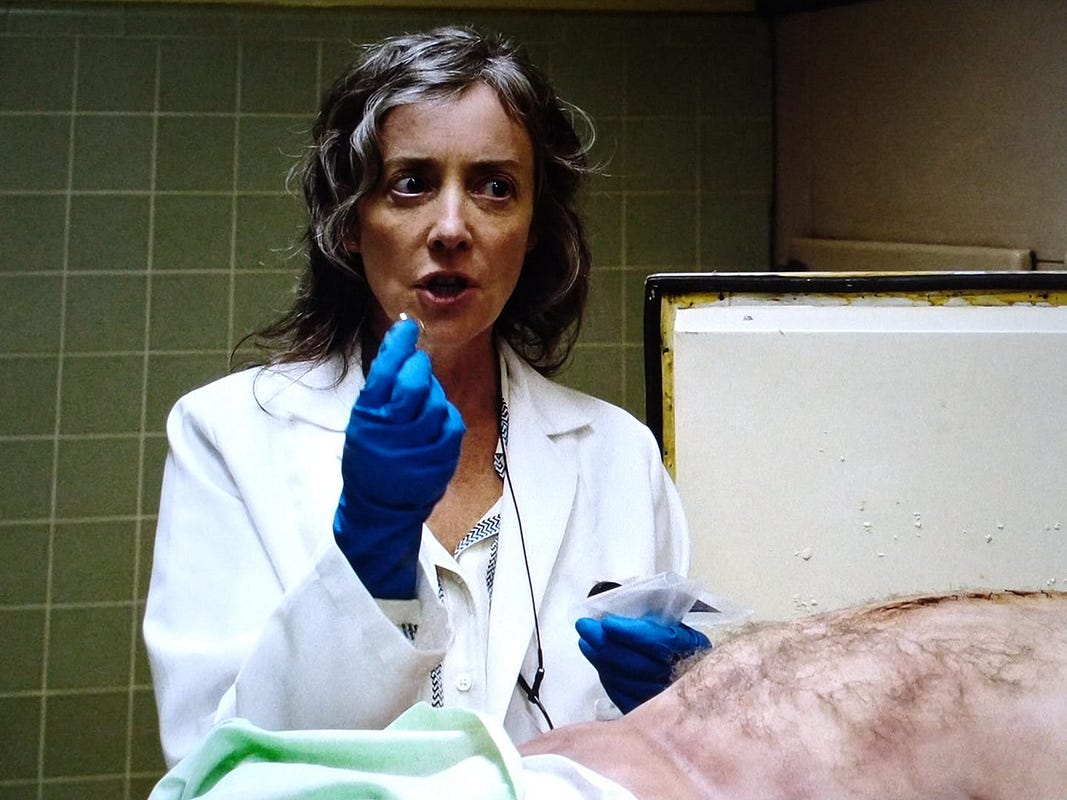


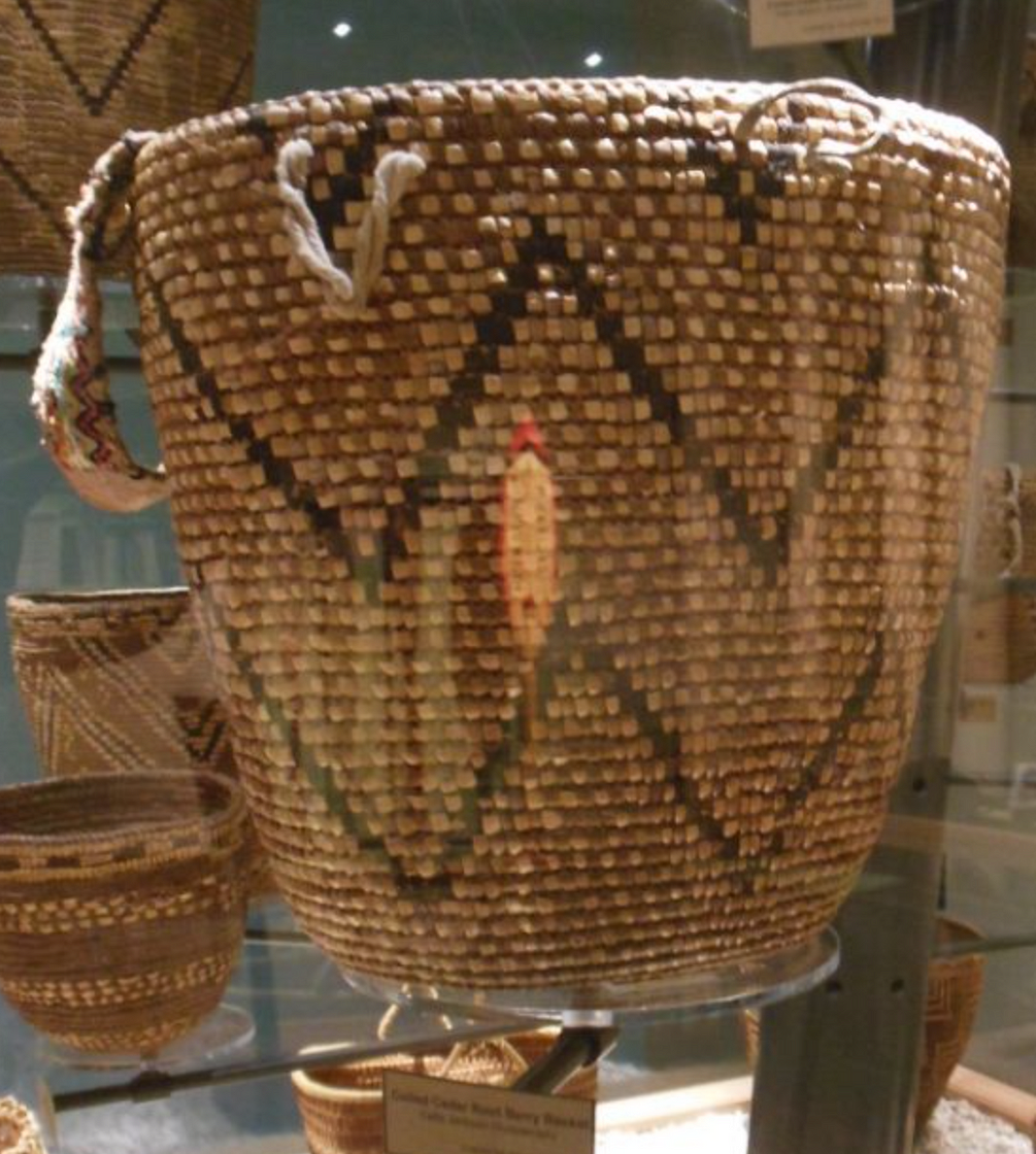
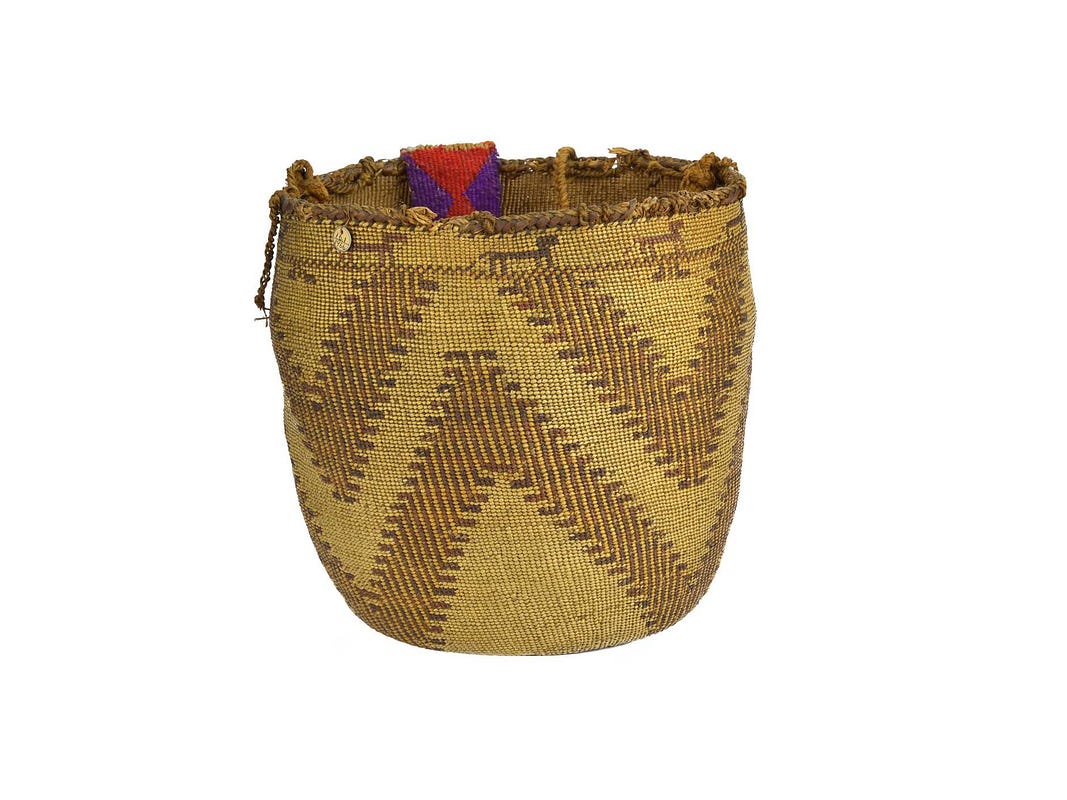
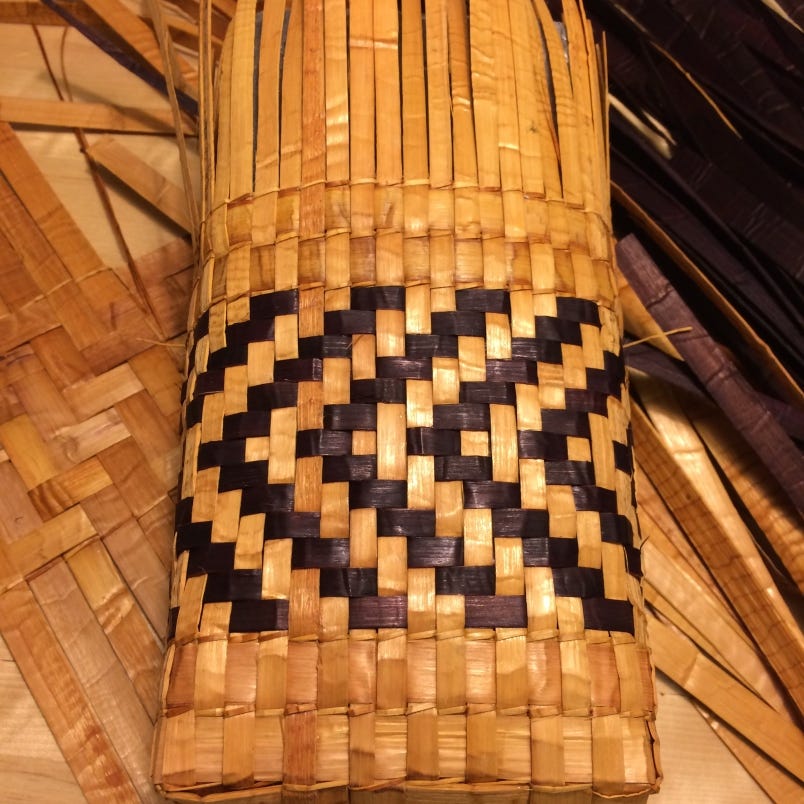

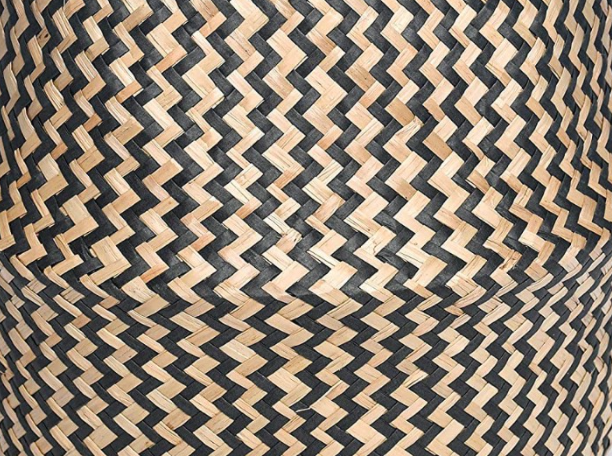

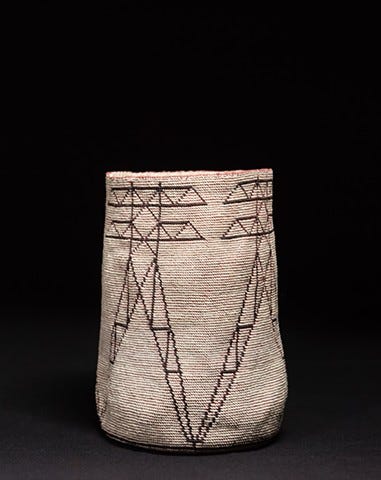
End Notes
The end credits for Season 1 rest on Laura’s picture. Her face is the end. During the devastating end credits for Season 2, we see a shot of a coffee cup on a table set against the chevron floor, and then the focus shifts to reveal Laura’s upside-down face reflected in the black coffee. Is it her homecoming picture? No, the face blinks! It isn’t a photo at all, but Laura, alive, posing for the shot.
The closing images of Season 1 and 2 become the opening image of Season 3: Laura’s homecoming face floating against the chevron floor and curtains. These icons, along with the waterfall and trees, set the stage for every part of Season 3, which will close, again, on Laura’s face in the Red Room, but this time it’s of her whispering into Cooper’s ear.
More Darkness
If it’s all Laura, then Naido’s eyeless face may be the memory of Leland covering up Laura’s face so she couldn’t see him raping her. The horse hiding backstage is Sarah hiding in the upstairs hallway. Ming and others suggest that the sudden loud, pounding “mother” in the Mauve Zone is a dream-transfigured Sarah pounding on Laura’s door while Leland is raping her. Maybe Laura was utterly terrified of her mother catching them. Maybe Sarah caught them in the past and did nothing. Maybe Sarah’s darkness is what attracted Leland to her in the first place. This is horrible.
Tim Krieder and others argue quite convincingly that Cooper is actually the killer who is stuck in a Lynchian fugue state. That’s why Laura screams bloody murder when she sees him in the woods. She sees her rapist.
But maybe all of Twin Peaks, even that epic twist, is just one of Larua’s dreams, probably while asleep in bed after having taken too many drugs getting ready to go out. From the script:
“She hangs up the phone and does another line of cocaine then swallows down a handful of red round friends from Bobby—the pills. LAURA: “Fifteen minutes… god, why did I say that?…”
Wait, hold the phone; did she overdose that night!? Are we watching three seasons of her bardo, and at the very end: lights out?





WOWBOBWOW So much joy! So much (waiting) room! Diane podcast dropped their long-awaited episode TODAY which—correspondingly? retrocausally?—focuses on the chevron pattern and waiting room.
A meaningful coincidence! Many wonderful parallel encounters: https://diane.libsyn.com/minisode-the-red-room
Oh cool! Synchronicity
this is the episode I meant to link to: https://diane.libsyn.com/the-waiting-room
A couple quick thoughts inspired by the article…
*The chevron patterns in the floor are analogous (yet much more orderly appearing) to the folds and bends in the tissue of the human brain.
*We have the Black Lodge, the White Lodge and is the Waiting Room somewhere in between… in the GRAY MATTER.
*You can enter the Waiting Room though dream, so a subliminal semi-brain design just might be appropriate.
*Where does dreaming actually happen? In the hippocampus which is in the central part of the brain. If you google what human hippocampus really looks like, it might remind you of the Eraserhead baby.
But what if it was always Ben Horne who was the abuser?
What if it was never Laura but was always Audrey Horne whom was the victim of the abuse?
What if the dreamer dreamt that it was the Palmers and not the Hornes to save his own family?
Honestly, look at it. If Laura was truly being abused would her abuser have ever let her interact with virtually EVERY single citizen in the town of Twin Peaks? No. Abusers isolate their victims, keeping them far away so people don’t know something is wrong and limit their victim’s resources to get help.
This fits Audrey more, whose father apparently even has her driven straight to school and then presumably driven straight back home.
She leaves for school in black and white saddle shoes, but switches into a secret pair of red heels once at school, implying a duality between what she presents long before we even see Laura’s divided heart necklace.
The chevron floor of the Red Room, with it’s red curtains mimic these colors. Audrey’s the one wearing the same color scheme in her photograph with Laura Palmer too: red, white & black.
I’m honestly believing that this is the heart of Twin Peaks: that it is the dream of Audrey’s son, the painful result of that incest and the subsequent victim of his mother’s own abuse. He dreamt Twin Peaks to shield them both from that abuse, to save himself from what he had become (William Hastings: a murderer of the women whom reminded him of and then disappointed him in regards to his mother, I believe) and to hide the fact that he was desperately in love with his mother but had accidentally caused her death.
Look at the birth of BOB and the events of Part 8. They echo Audrey Horne and her pregnancy more than Laura or the Palmers.
There’s a bomb and the Experiment gives “birth” to BOB. Afterwards, we see a girl walking home with a boy and along the way she finds a penny. The same girl will become unconcious as the song she is listening to, “My Prayer”, will be interrupted as some man talks about drinking water, descending and potentially becoming unconscious/unseeing. Then a frogmoth eventually sneaks into the girl’s room, crawling into her, in effect impregnating her with itself.
We know that before the conception of her child, Audrey, a hotel girl, was tied up at a place where many pennies were kept, a bank (Teresa Banks, the first victim, a fellow motel girl, her double inside of the dream, the dreamer masking his brunette victims under blondes), she requested some WATER, the old man held it up for her as she DRANK it. She asked for someone to contact Agent Cooper, then heard a phone ring and a guard announce “A boy? It’s a boy! It’s a boy!” before a bomb went off. She was sent to the hospital, presumably was in a coma (asleep), when Mr. C snuck in and then impregnated her.
She bore a son and his name was Richard.
Eventually, after having sex in a motel room, as the song “MY PRAYER” is heard (in strong ways recalling Audrey Horne’s prayer to him and referencing a dream), Cooper, Audrey’s first love, turns into a Richard and the motel just as suddenly switches to a hotel.
The stunning, overwhelming implication, for me, at least: Dale Cooper (or whomever he is outside of the dream, Billy Hastings, I still suspect) is Audrey Horne’s (or whomever she is outside the dream, Judy possibly’s) son.
And he remains hopelessly in love with her.
The mother’s rape at his own hands becomes horribly symbolic when we realize it was probably, infact, her father whom impregnated her and not someone else: the son feels like his existence virtually raped his mother every day he lived, keeping her emotionally in stasis, being a constant reminder of her own pain and sorrow.
Life became garmonbozia to him, an endless cycle of pain and, something he lived and fed on because that was all he saw himself as. Creamed corn represents both his mother and father to him and thus his horrible conception and continual torment because he hurt the only person he loved.
Only when we accept Laura Palmer as the Macguffin that she truly was can we then push past everything to see the true tragedy of Twin Peaks and the fact that its portrait of incest ran deeper and even more powerfully than when it was projected falsely on the Palmers by the effigy of BOB, whom is a mixture of both father and son.
This wasn’t just a portrait of one daughter being abused.
It was the sad story of a man abusing his daughter and that same daughter keeping the cycle painfully going when she abused her own son.
Audrey Horne and Dale Cooper.
The little girl and the little boy who lived down the lane.